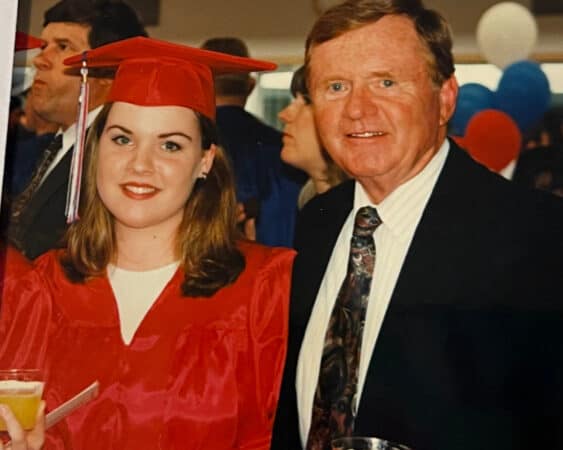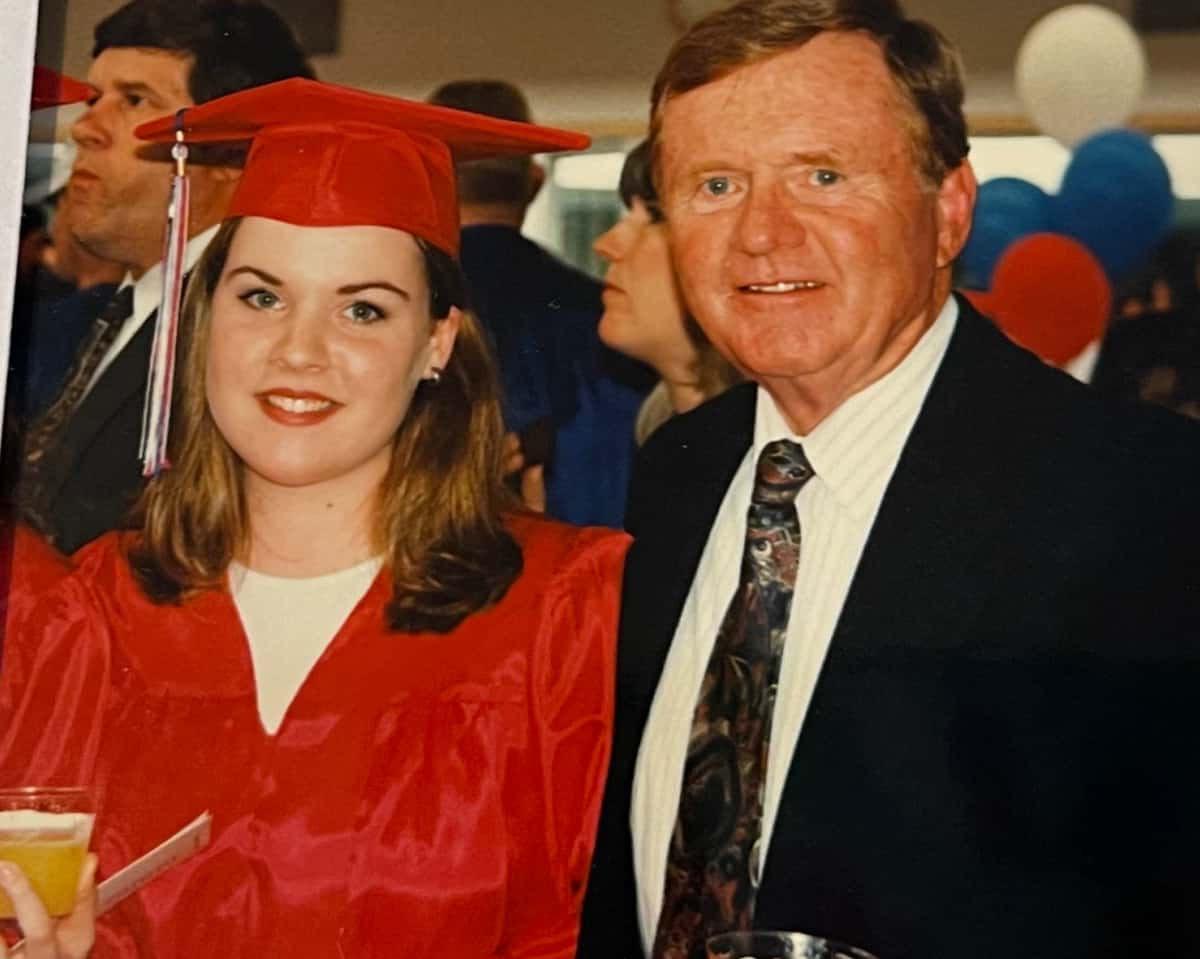I steadied my father’s hand on a fork to slowly lift a bite of potato. At that same oak table, he sat in his designated head-of-the-table chair and taught me manners before he started showing signs of the same kind of dementia Bruce Willis has, when I was 13. Now I was feeding him in my mid-twenties, he in his late seventies.
As a 40-year-old mom with 5 children of my own, living in California, I came to visit the home I’d grown up in, in a Seattle suburb. It felt like stepping into another lifetime, mentally and physically.
Being there now, facing the table where I had eaten a hundred dinners, and rushed through breakfast every morning before school, I felt unsettled. I bit my lip thinking about the life that unfolded around this swirly-grained oval next to a modest kitchen with Formica counters and fluorescent lights, built in the 70’s before expansive floor plans of granite and dimmable lights.
Our family life revolved around our kitchen table
Growing up, I heard things like, “One of you is going to get this table someday!” I heard the features of it so many times I actually believed I would surely be lucky to get this 80’s country-décor treasure with clawed feet and chairs. It was ceremonial when we moved our rustic round picnic table and benches outside and finally replaced it with inside furniture when I was in elementary school.
There were rules for this new show piece. We had to “keep it nice.” My mother insisted on keeping it covered with a pad and tablecloth most of the time. I was trained to quickly wipe away a spill if the wood were exposed so as to not damage the wood. I learned to polish it with orange oil and a dust rag.
We didn’t want the world to see what was happening in our family
I covered it soon after if we used placemats for a particular event and was careful not to bump our giant Kirby vacuum into the legs. We wouldn’t want it to get scratched or show wear, would we?
Somehow, something 30 years old still looked new underneath the tablecloth. If I’d known it was going to be the last time I was in that home, I might’ve spent even just a few more minutes studying it. I knew the effort it took to keep up the table’s appearance which became a metaphor for how we were expected to appear to others. I wanted to remember what it looked like.

My dad withered from a vibrant school principal into a silent shell of himself as his frontal temporal dementia progressed. As a girl, I comforted myself with warm homemade cookies in one of the bulky chairs, confused as my dad unintentionally started showing irritability and depression-like symptoms of dementia that didn’t take long to take over his personality.
His lack of interest in me left a chill in my chest. He no longer seemed interested in me and had little patience for a giggly teen girl who was often described as a “valley girl,” because of how I drew out my words.
We children became the caregivers
My brother and sister and I switched our roles from children to caregivers from the time we were teens. There were unwritten rules- we acted like everything was fine to others while our world at home unraveled. As a teen, there were times I’d drop my utensil and rush from the table in a panic because my dad found the car keys.
I’d try to block the front door and tell him he couldn’t drive, but he’d get out anyway. He was never physically abusive and would never think to hit me, but he was my dad. I’d eventually step away, ashamed. It felt like it would be my fault if he hurt anyone in a crash, and I’d never tell anyone outside our family of these situations. I’d look out the window, relieved when I’d finally see the headlights coming down our street in the dark.
Our mother was too young to have to take care of her husband
Our mother probably felt too young for this fate, as she continued to work as a middle school teacher, and longed to fit in with church friends that were her age, not geriatric care of her husband, 21 years her senior.
I moved across the country twice in my twenties to escape the emotional burden of caregiving. When I finally could afford to rent an apartment of my own, I never set up a table to eat at and when people came over, we’d eat on the couch and break all the etiquette rules. Something deep inside me rebelled against caring what other people thought.
Reset by time and distance living in a different state, I tenderly surveyed the 4-bedroom house I grew up in that had become more like a museum with a collection of 40 years of living. The table, draped in seasonally themed covers, was one uncluttered spot we gathered, and I learned to keep the conversation from veering off into uncomfortable topics and make light of what we were going through.
When my mother sold our childhood home, my siblings and I didn’t want the table. All the effort it took to keep that oak looking shiny by covering it up made me laugh. I’ll never know who was lucky enough to get it. That table knew all our secrets, and I was happy to leave that heavy piece of furniture in the past.
In my new California home, I had splurged on a sleek, gray-stained wood table for my own growing family. I instinctively bought a tablecloth for it but pulled it off the day after.
My toddlers were banging their sippy cups on it and my older children scratched it with forks and craft supplies. I could see scuffs and wear on the table within weeks of purchasing it, but I didn’t want to hide any of it. Unlike my mother, I wanted to see the wear and tear of life on my children, which were often the result of not just hard moments, but joy.
I hope that our modern table sets the tone for our family ethos
My hope is that our modern style table reflects my desire to let what I can and can’t control just be what it is, inside our home and to others– the joy, grief and flaws. I can see how my mother must have been overwhelmed by 3 teenagers and caregiving. Her emotional needs could be overwhelming to me as a teen and young adult—but I helped prop up the image she wanted to portray.
When I moved back to Seattle for the last time, I was made to feel guilty that the hours I spent with my parents were not enough, and I often felt seen as a child, rather than the independent adult I had become. It was at that same table we made funeral and memorial service plans for my dad when he finally passed.
It was time to move forward.
I don’t expect my kids to want my kitchen table when the time comes
I don’t expect any of my kids to want our gray table, or any of my furniture that will probably look “so 2020’s” to them someday. Heck, I even get sick of my own style sometimes. Our table shows traces of nights helping with homework, books read that land in breakfast syrup, friends and family that squeeze around it for birthday cake, slime and glitter splattered across it mixed with a peanut butter and jelly sandwich.
There is laughter, arguing, announcing family news and the eww-gross-I-can’t-watch-him-eat moments and me yelling at them to clear the table for the 100th time. This is my moment to be a mom and I know I’ll mess up, but I’ll certainly try my best.
Protecting our family image is not my goal
Protecting how our family looks to others at the cost of honesty during times of sorrow and struggle? I know how bad that felt– and thankfully there is so much more acceptance and support for brain diseases like dementia and counseling services that were considered taboo one generation ago.
I’ve got a tween who needs to vent about an F on a math test over some chips and queso, and a teen who needs me to help her hot glue gun a castle for history. It’s all happening this evening at our table.
I’ll need my children to extend grace for all the mistakes I will make as their mom, but hopefully we can talk about it over dinner.
More Great Reading:
Finding My Way Through the Grief of Losing My Mom

 PARENTING TIPS
PARENTING TIPS PREGNANCY
PREGNANCY BABY CARE
BABY CARE TODDLERS
TODDLERS TEENS
TEENS HEALTH CARE
HEALTH CARE ACTIVITIES & CRAFTS
ACTIVITIES & CRAFTS


